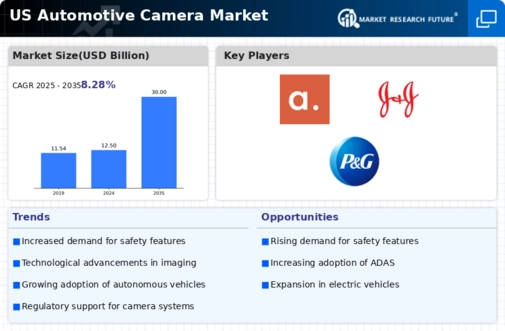Growing Adoption of Electric Vehicles
The growing adoption of electric vehicles (EVs) plays a pivotal role in shaping the automotive camera market. As EVs gain traction in the US, manufacturers are increasingly incorporating advanced camera systems to enhance the driving experience and ensure safety. In 2025, it is anticipated that the EV market will account for over 30% of new vehicle sales, leading to a corresponding rise in demand for automotive cameras. This trend indicates a shift towards more technologically advanced vehicles, where the automotive camera market is expected to thrive. The integration of cameras in EVs not only aids in navigation and parking but also supports the development of autonomous driving features, further driving market growth.
Rising Demand for Vehicle Safety Technologies
The automotive camera market experiences a notable surge in demand driven by the increasing emphasis on vehicle safety technologies. As consumers become more aware of the benefits of advanced safety features, manufacturers are integrating cameras to enhance visibility and reduce accidents. In 2025, it is estimated that the market for automotive cameras will reach approximately $5 billion in the US, reflecting a growth rate of around 15% annually. This trend is further supported by regulatory bodies advocating for stricter safety standards, compelling automakers to adopt innovative camera solutions. Consequently, the automotive camera market is poised for substantial growth as safety becomes a paramount concern for both consumers and manufacturers.
Technological Advancements in Imaging Systems
Technological advancements in imaging systems significantly influence the automotive camera market. Innovations such as high-definition cameras, night vision capabilities, and 360-degree views are becoming increasingly prevalent. These enhancements not only improve the functionality of cameras but also contribute to the overall driving experience. In 2025, the market is projected to witness a shift towards more sophisticated imaging technologies, with an expected increase in sales of high-resolution cameras by 20%. This evolution in technology is likely to attract more consumers, thereby expanding the automotive camera market. As manufacturers invest in research and development, the integration of cutting-edge imaging systems will likely redefine the standards for vehicle safety and convenience.
Regulatory Support for Enhanced Vehicle Safety
Regulatory support for enhanced vehicle safety is a driving force behind the automotive camera market. Government initiatives aimed at improving road safety standards are encouraging manufacturers to adopt advanced camera technologies. In 2025, it is expected that new regulations will mandate the inclusion of rearview cameras in all new vehicles, which could potentially increase the market size by 10%. This regulatory push not only promotes the adoption of automotive cameras but also fosters innovation within the industry. As the automotive camera market adapts to these regulations, manufacturers are likely to invest in developing more sophisticated camera systems, ensuring compliance while enhancing vehicle safety.
Increased Focus on Driver Assistance Technologies
The automotive camera market is significantly impacted by the increased focus on driver assistance technologies. As consumers seek vehicles equipped with features that enhance convenience and safety, manufacturers are responding by integrating advanced camera systems. In 2025, it is projected that the market for driver assistance technologies will grow by approximately 25%, with cameras playing a crucial role in systems such as lane departure warnings and adaptive cruise control. This heightened interest in driver assistance technologies suggests a robust future for the automotive camera market. As automakers continue to innovate and improve these technologies, the demand for high-quality camera systems is likely to escalate, further solidifying their importance in modern vehicles.














Leave a Comment